Nonprofit organizations do great things to make the world a better place — and often on a shoestring budget. Driving awareness to your cause is typically one of the most critical (yet challenging!) parts of the job, and social media is a great place to get the word out.
Social media for nonprofits is different from most industries because the stakes are high. Goals include, but are not limited to, growing your donor base, recruiting volunteers, and sharing your impact. No small feats!
However, with a little education, a social media strategy, and the right tools, any nonprofit social media account can reach its maximum potential. Keep reading, and we’ll show you how.
Key Takeaways
- Social media helps nonprofits do more with less. Even with tight budgets, the right strategy can grow your audience, attract donors, and bring your mission to life.
- Authenticity builds trust and engagement. Nonprofits that share real stories, impact updates, and behind-the-scenes moments connect more deeply with their communities.
- Strategy beats spontaneity. A clear plan — from knowing your audience to choosing the right platforms — helps you stay consistent and make the most of every post.
- Tools and teamwork make it scalable. Social media management platforms like Hootsuite (and creative tools like Canva) help small teams save time, stay organized, and turn awareness into action.
There are 5.17 billion social media users in the world, a number that’s only growing each year.
But people aren’t just on social media to connect with friends. In fact, Americans spend over five hours a week learning on social media.
If you want to spread the word about your cause, social media is a great place to post about your cause and give people something new to learn about.
Here are some other ways to use social media for your nonprofit:
- Drum up donors (who keep coming back)
- Recruit qualified volunteers
- Connect with clients of your programs
- Create an engaged community of supporters
- Get your important issues in front of the right audience
- Ask for donations on social media
Let’s go over some of these benefits in more detail, along with real-life examples of nonprofits using social media.
Promote awareness to your cause
Social media is an easy, effective way to spread the word about your organization’s mission.
People can’t get behind you if they don’t know what you’re all about, right? Drum up support for your cause with regular reminders of what you do and who you help.
Bat Conservation International, for instance, often shares Facebook posts that inform audiences about how the nonprofit works with bat habitats — while also educating people about different bat species.
Source: Bat Conservation International
Drive fundraising efforts
Social media is a natural fit for your next fundraising drive. Include donation links in your posts or Stories, and pop one right into your social media bio, too, to make it super easy for anyone to help fund your cause.
Whether you’re promoting a specific fundraising campaign or encouraging people to contribute regularly, followers can donate in just a few clicks.
According to Katherine Bruchalski, Digital Media Manager at EarthDay.Org, social media also offers nontraditional ways to fundraise.
“While this might not be the first tool you think of for nonprofits, Instagram’s shopping features can actually help with fundraising too,” says Bruchalski.
“By integrating things like merchandise or donation campaigns directly into the platform, you can boost awareness and drive donations as social commerce continues to grow.”
Connect with your clients
Being accessible to clients and donors is important for any nonprofit. If someone has questions about your services or is eager to make a significant donation, you’re going to want them to be able to reach you.
By operating a social media account (or accounts), you’re creating multiple avenues for connection. And increasingly, social media is the preferred communication tool. So why not be available to chat with your supporters or members in a medium that works for them?
For instance, Dress For Success makes it easy for its LinkedIn followers (presumably a supportive group for its cause) to get involved through the specific link in its bio.
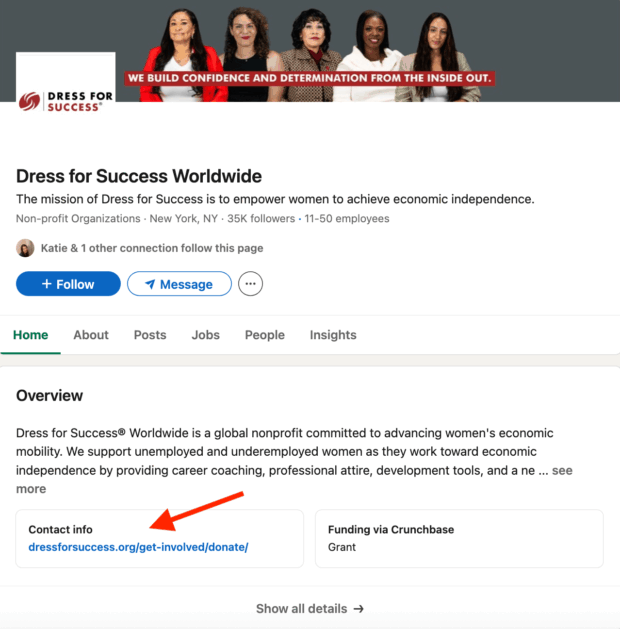
Source: Dress For Success
Share your impact
Social media is the perfect place to talk about the impact you’re having. Post about your accomplishments after a big fundraising drive, or share screencaps of your Annual Report.
Or, get personal, and share real-life stories of people who have been impacted by your work. Wins that might otherwise be buried deep on your website are now front-and-center in your followers’ feeds.
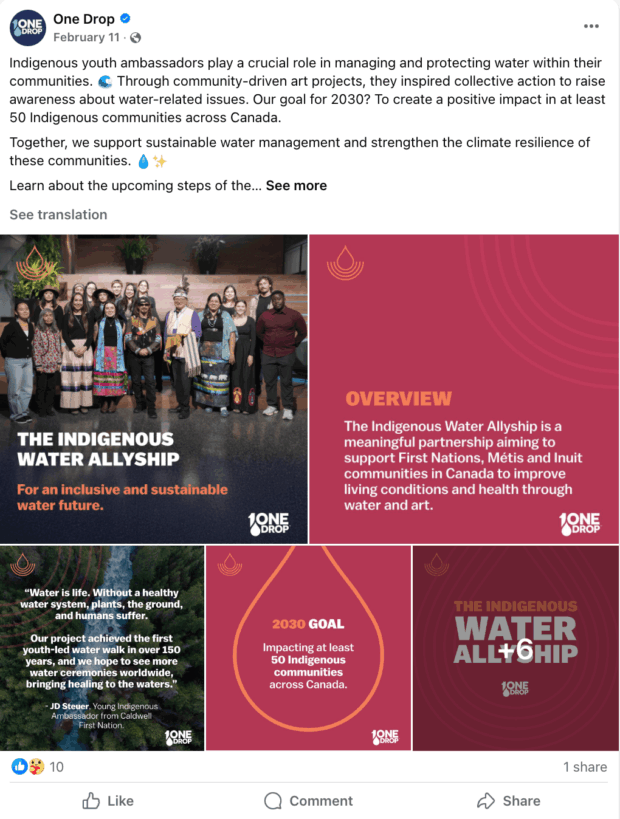
Source: One Drop
Build a community for supporters
When you create a social media account for your nonprofit, you’re also building a digital gathering space for your supporters. Like-minded folks can share ideas, chime in on conversations in your comments section, and feel a sense of inclusion and belonging.
Promote a specific campaign or event
If you’ve got an upcoming gala, volunteer drive, or special campaign event, social media is a natural spot to promote it.
The people following you on social are opting to learn more about what you do: a prime audience to support your initiatives.
Plus, posting about an event on social media, like EarthDay.Org does on Instagram, offers you the opportunity to be discovered by new users and supporters, thanks to social search and discovery tools.
Get that word out!
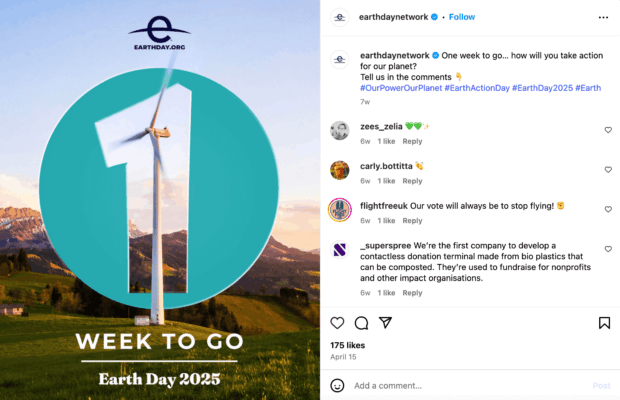
Source: EarthDay.Org
Pro tip 💡: When promoting a special campaign or event, tag any collaborators or sponsors in your social media content to amplify the reach.
Recruiting volunteers
We’re not saying putting up posters in your local coffee shop isn’t effective, but why not reach an even wider audience by advertising volunteer opportunities via social media?
Think of these platforms as digital community corkboards (especially now that many volunteer opportunities are virtual or online-only, too).
For example, in this Facebook post, nonprofit organization Austin Parks Foundation highlighted recent volunteer projects as a way to encourage other people to sign up for volunteer opportunities.
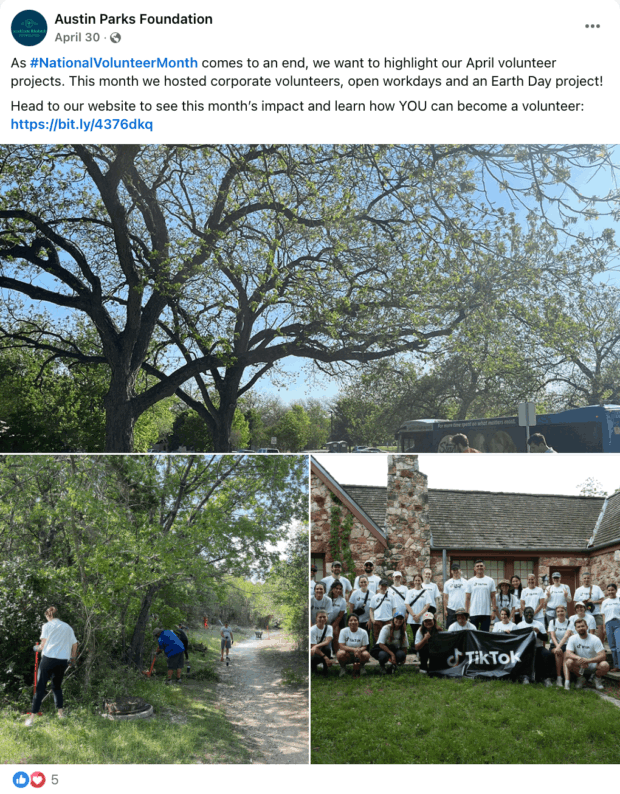
Source: Austin Parks Foundation
Grow your donor base
As you grow your social media audience, you’re growing a potential donor audience as well. Every person who follows you (or stumbles across your funny TikTok) is someone who might reach for their credit card and support your cause.
Adding a donate button to a profile or post, or a link sticker in your Instagram Story, is an easy way to convert a potential donor. Follow this by communicating your impact as a nonprofit and you’ll start building the relationship that is essential to engaging repeat donors.
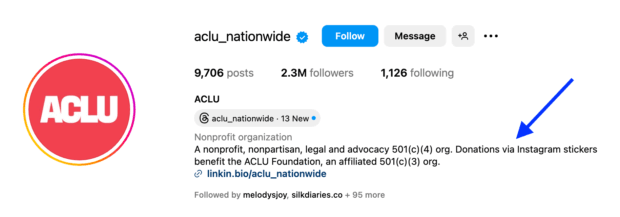
Source: ACLU
Pro tip 💡: Making donations via social media is still a relatively new concept. Reassure your followers that their donations are secure and go directly to your organization, as the ACLU mentions in its Instagram bio.
Communicate in times of crisis
If you’re looking to get the word out to as wide of a group as possible, social media is your best bet.
Say your dog charity has received a surprise influx of puppies that need adopters urgently: social media is a powerful tool to use, along with newsletters, website updates, phone calls, or letter campaigns.
Given how many folks turn to social media for updates during times of disaster, social is also a critical channel to communicate potentially life-saving information in times of crisis while also keeping an ear to the ground as to what people are talking about or where help is most urgently needed through social listening tools.

Source: Austin Animal Center
Work with your budget
While it would be the dream to see nonprofits advertising during the Superbowl, the reality is that marketing and ad budgets are often pretty slim for this group.
One of social media’s benefits is that you can achieve incredible reach for free with a little investment of time. If your nonprofit is stretched thin, social media may be a cost-effective way to achieve your digital marketing strategy.
(Of course, if you do have a few bucks to spend, social media advertising might be a good fit for your organization — learn more about social ads here.)
Many nonprofits are working with a limited marketing budget, which means social media efforts often need to be organic.
No problem. You actually don’t need a lot of cash (or any!) to achieve success with your nonprofit social media strategy.
Here are 13 tips for running a winning social media plan for your nonprofit organization.
1. Set up your social media accounts as nonprofit
Most social media platforms offer special tools for nonprofit organizations, so make sure to register your accounts with nonprofit status. Even Hootsuite offers a special discount for nonprofits with our Hootgiving program.
Here are a few other platform-specific actions nonprofits can take:
Bonus: Get a free social media strategy template designed specifically for nonprofits. Use it to save time planning content, tracking results, and keeping team members up-to-date.
2. Identify your audience
A nonprofit social media strategy isn’t really that different from a for-profit social media strategy. Before diving in, it’s vital to think about who your audience will be — think about ages, interests, genders, and nationalities.
As Bruchalski recommends, get clear on who you want to reach — whether you focus on age, location, or values.
“For us, that could mean eco-conscious millennials or teachers looking for green resources,” she says. “The more you know your audience, the better you can tailor your content to resonate with them.”
These details will inform the tone and content of your social media posts and may even determine which social media platforms will be best for you. Social media analytics tools can help you see who’s already following and engaging with your content, but you can learn more about identifying your target audience here.
3. Choose the right platform(s)
Consider this your permission to pass on TikTok if it’s not a good fit for your org.
The fact is, you don’t have to be on every social media platform, especially if you have a limited budget. Each social media platform has its own unique audience demographics… and not every platform will be a good fit for you.
Take the time to think about what makes the most sense for your organization. Is your audience hanging on Facebook, or are your donors more of an Instagram crowd? Being selective will help ensure you aren’t spreading your attention too thin. The best social media platforms are the ones that get you in front of your target audience.
The National Science Foundation, for instance, is a great fit for a science-and-tech-obsessed audience on X, as its 1.2 million followers can attest. YouTube is also a successful channel for its educational video content, as shown below.

Source: National Science Foundation
That being said, if you do decide that multiple social media platforms make sense for your brand, a social media management tool like Hootsuite can make it simple to schedule posts and deal with incoming messages in one place.
Learn more about how nonprofits can save 75% on Hootsuite here.
4. Craft a clear brand story
Your nonprofit has a strong mission, so make sure it’s clear when you’re talking about it on social media.
To ensure your content engages with the right audience, Bruchalski recommends sharing a narrative that connects.
“For example, ‘Invest in Our Planet’ calls for collective action, while personal stories make the mission feel relatable,” she says. “Staying true to your values and keeping your message authentic will help your content stand out.”
Along with a clear brand story, your posts also need strong calls to action. Sometimes this may be to “donate now” but other CTAs for your nonprofit include:
- Sign up for our newsletter for updates
- Register for our next event
- Learn more about volunteer opportunities
5. Create an editorial calendar
We know, we know: creating engaging content consistently is easier said than done. In fact, it’s something most nonprofits struggle with.
In our Hootsuite nonprofit survey, we learned that 36% of nonprofit social media managers agree it’s hard to ideate and create quality content.
Another 41% said they don’t have time to dedicate to creating and implementing effective strategies.
A content calendar can help lighten the creative load and keep your nonprofit team on the same page. It also allows you to plan ahead so teams with limited resources aren’t stretched too thin or left scrambling to put things together at the last minute.
Anticipate key events that are important for your cause or content pillars you can return to regularly. Decide in advance when it might be good to promote fundraisers or events on social media.
Once you’ve plotted your future posts, you can determine your posting frequency and start scheduling content.
6. Post at the right time (consistently!)
Our nonprofit survey revealed that 19% of nonprofit social media managers don’t know the best time to post.
Good news: we break down the best times by platform here. (Though it’s good practice to also check your analytics to confirm when your followers are most online and likely to see your posts.)
Pro tip 💡: Hootsuite will suggest customized best times to post when you schedule your posts through our social media dashboard.
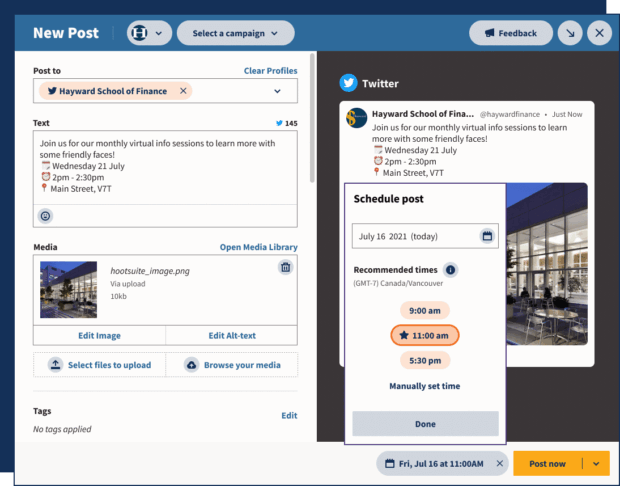
Learn more about Hootsuite tools for nonprofits here.
7. Analyze your results
It’s hard to improve your engagement and reach if you don’t know what works. Nonprofits can use social media analytics tools to learn what resonates with audiences and what is a flop.
When it comes to donation drives, awareness campaigns, or fundraisers, real-time data can be particularly valuable.
Pro tip💡: Get familiar with Hootsuite Analytics to regularly evaluate your social media performance and learn exactly what kind of posts convince people to engage with you or hit that “donate” button.
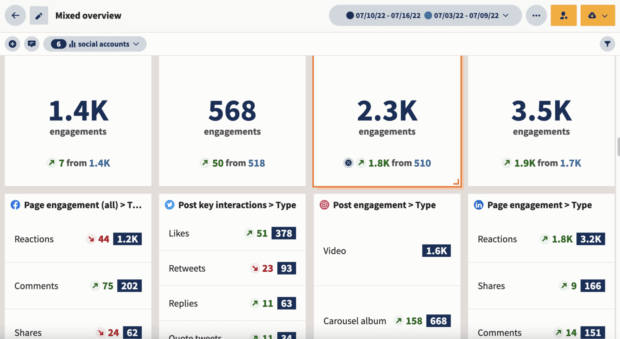
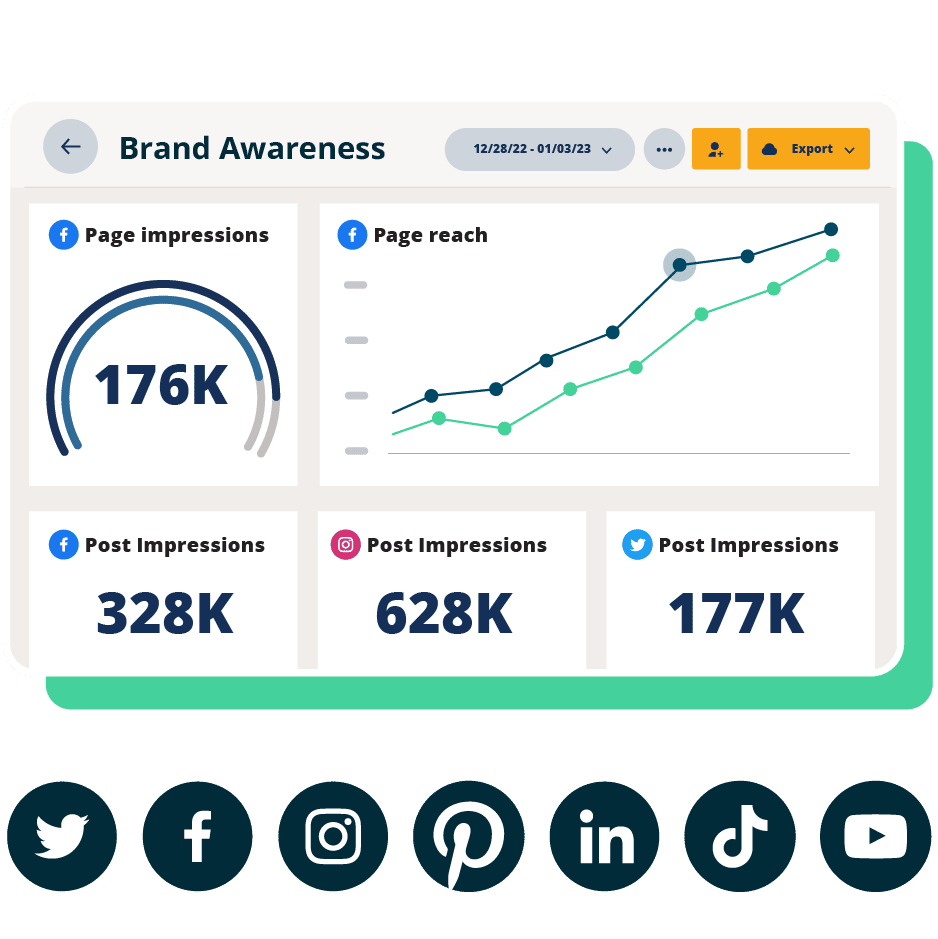
#1 Analytics Tool for Growth
Beautiful reports. Clear data. Actionable insights to help you grow faster.
Start free 30-day trial
8. Leverage short-form storytelling
Anything can be turned into a story, even the seemingly routine parts of your job, suggests Nick Slater, Co-founding Partner of Pisano Slater Enterprises, a communications firm that works with nonprofits.
“Nonprofits can focus on sharing the ‘insider information’ they have about their area of focus,” he says. “Even logistics can be a source of fascinating mini-stories, e.g., how *do* you get ten thousand baby shoes from Tampa to Mozambique?”
The best way to share short-form stories are with Reels, TikToks, and even Instagram Stories. For instance, Al Barro Foundation used Reels to recap an event they participated in.
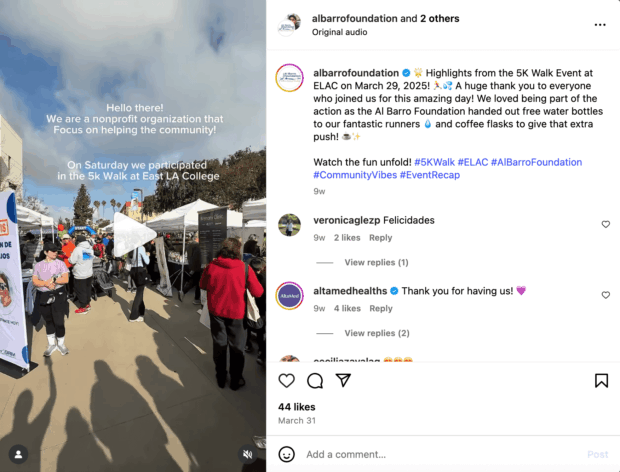
Source: Al Barro Foundation
9. Create social media policies
Nonprofit organizations often don’t have the resources for one dedicated social media person.
If you’re sharing the load of social media management as a team, it’s a good idea to create a social media policy to make sure the expectations are clear for anyone who is tweeting on the organization’s behalf.
Here’s how to write a social media policy, with a free template to get you started.
10. Embrace social SEO and hashtags
Getting discovered by new people is a big-time goal for nonprofits. So, growing your audience using social search optimization and hashtags is a must. It’s pretty hard to increase your follower count if people can’t find you — so it’s smart for nonprofit social media managers to brush up on their social SEO basics.
As social platforms improve their keyword search capabilities, our opportunity to discover new accounts increases. Pack your account bios and captions with keywords and relevant hashtags for the quickest follower growth.
Nonprofit organization Texas Book Festival used popular hashtags including #booklover and #bookstagram to promote a fundraising shopping event.
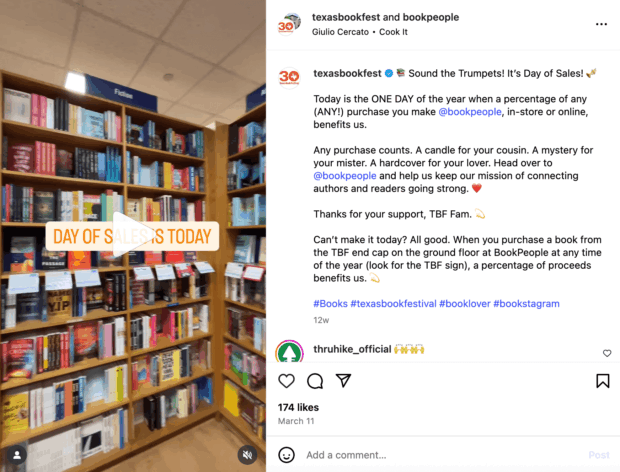
Source: Texas Book Festival
11. Partner up with ambassadors
Social media offers an easy way for nonprofits to team up with ambassadors, collaborators, influencers or even other nonprofits to spread the word about their cause.
Since nonprofits may not have the budget to work with influencers, it’s important to connect with other relevant collaborators.
“Nonprofits that want to grow their social media presence need to find ways to partner with larger accounts in similar or adjacent fields,” suggests Slater.
“This involves building relationships offline, and it requires having something to offer those larger accounts, whether that’s eye-catching pictures, personal testimonials, or unique data that only your nonprofit can provide.”
Learn more about pulling off the perfect social media collaboration.
Pro tip💡: When sharing collaborative content on Instagram — whether you’re partnering with another nonprofit, a vendor, or a local business, for instance — use the “Add a collaborator” feature. This allows you to reach new audiences and amplify your message.
12. Be responsive
Whether you’re communicating with potential donors, eager volunteers, or the very people or communities that your organization is trying to help, being responsive to messages is vital.
If you’re operating multiple social media accounts, it can be helpful for nonprofits to have a tool that helps you monitor incoming messages across all social media channels in one place.
Hootsuite Inbox is a great example, not only does it pull all of your DMs and comments into one place, but you can also assign each message to other teammates or volunteers.
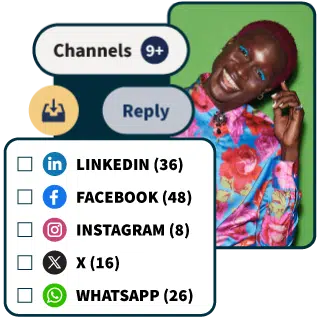
Reduce response time (and your workload)
Manage all your messages stress-free with easy routing, saved replies, and friendly chatbots. Try Hootsuite’s Inbox today.
Book a Demo
13. Host an online event
One cool feature of social media that nonprofits can take advantage of is live-streaming. Hosting an online event means anyone, anywhere, can tune in and participate.
Even if you’re having a real-life event, creating an online component can accommodate another digital audience.
Live videos are an exciting and engaging way to watch the magic happen — live, unfiltered, uncut! — right there on your phone screen. What better way to incentivize donations and build awareness?
Learn more about live-streaming on social media here.
14. Create fundraisers and add donation buttons
Many social media platforms (i.e., Instagram, Facebook, TikTok, and Snapchat) offer built-in fundraiser and donation tools for nonprofits to use. Start a donation drive right on your Facebook page, or add a “Donate” sticker to your Instagram Story.
Being able to run donations online is a game-changer for many nonprofits, especially when done in tandem with in-person campaigns. You’re making it easier for donors to support your cause. The fewer clicks someone has to make, the better.
Plus, when you sign up as a nonprofit on Facebook and Instagram, you also make it possible for individuals to set up fundraisers on your behalf.
Diving into social media without a strategy is a surefire way to feel directionless. Save yourself and your team time and effort by using a ready-to-go social media strategy template.
Claim your free nonprofit social media strategy template to create a strong social media presence for your organization in 2025.
1. Hootsuite
Monitoring incoming messages, bulk composer, reporting, scheduling, post boosting, social listening, storing post templates, and more is quick and easy with our multi-functional social media management dashboard.
Nonprofits can save up to 75% on Hootsuite and up to 50% on social media training courses through Hootsuite Academy (a huge deal if you’re onboarding new volunteers every quarter!). Unlock the power of social media to reach a global audience and amplify your cause at scale.
Pricing:
SMM star rating:
⭐⭐⭐⭐⭐ (5/5)
My favorite features:
- Best Time to Publish tool: As a busy nonprofit marketer, the last thing you want to worry about is what time to publish on social media for the most reach and engagement. Hootsuite’s built-in analytics recommends the best times to post based on your past performance — it takes the guesswork out of scheduling and publishing your nonprofit’s content.
Where there’s room for improvement:
- Learning curve for nonprofits: If you’re new to using social media marketing tools, there’s a chance you may find all of the features overwhelming. Luckily, the Hootsuite Help Center covers every topic you may need help with.
Customer review:
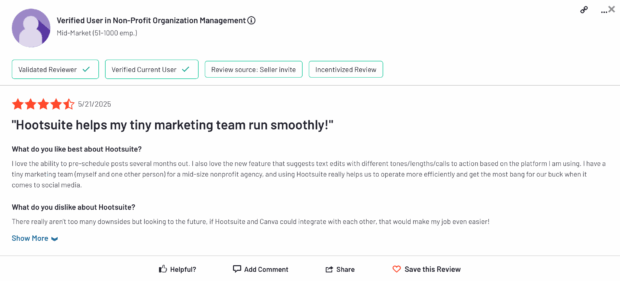
Source: G2
2. Canva
Where would us marketers be without Canva?
In a world as visual as social media, professional graphics are non-negotiable. Enter: Canva.
The graphic design tool makes it easy to create content for every social channel, whether you’re putting together a carousel post of your impact report for LinkedIn or sharing an infographic on Instagram.
Bonus: Canva is built into Hootsuite’s Composer to make your content creation process seamless.
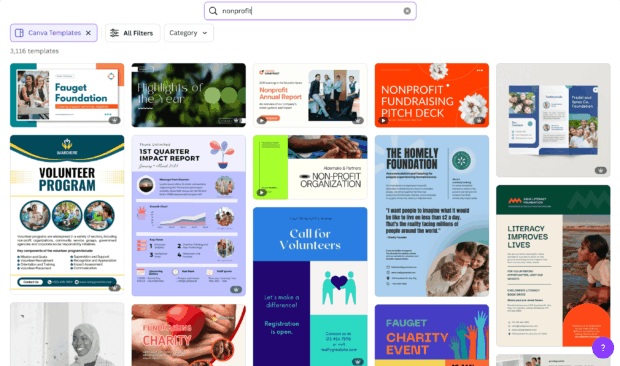
Source: Canva
Pricing:
- Free; paid plans starting at $15/month.
SMM star rating:
⭐⭐⭐⭐⭐ (5/5)
My favorite features:
- Professionally-designed templates: Canva offers over four million customizable social media templates for every channel. They’re automatically sized with the right specs, so you don’t need to spend time resizing posts for different platforms.
Where there’s room for improvement:
- Learning curve: While templates make the graphic design process more accessible, it can still be overwhelming if you don’t have much design experience. My recommendation is to start simple before working your way up to more advanced effects.
Customer review:
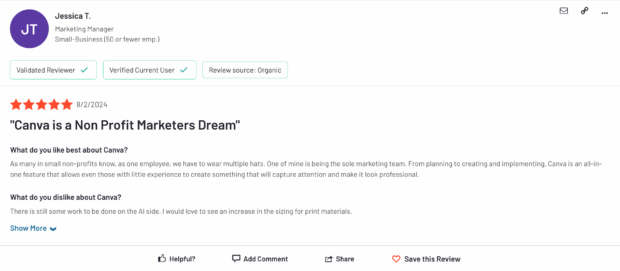
Source: G2
3. Unsplash
We all know visuals make a powerful impact on social media. Ideally, your content will feature real humans (or other species!) who your nonprofit has worked with.
However, if you don’t have the resources to spend on professional photography or videography, Unsplash is a great free alternative. With over 6 million contributed images, the platform is a reliable place to find professional images for all of your marketing content.
Check out more free stock photo websites.
SMM star rating:
⭐⭐⭐⭐ (4/5)
My favorite features:
- Search and filtering functions: My favorite feature of Unsplash is how easy it is to find a certain image style. Simply search for a subject or style you have in mind — for instance, a group of dogs — and Unsplash will present many options in a variety of sizes and types.
Where there’s room for improvement:
- Lacks variety: Spend enough time on Unsplash and you’ll start to see familiar images (you may even see other social accounts using the same ones!). Mix in original imagery from your organization to find a balance and bring some personality into broad stock images.
Customer review:
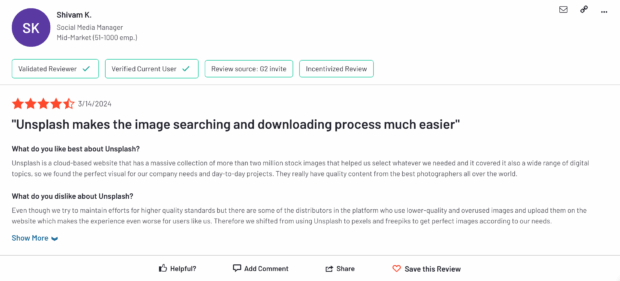
Source: G2
What social media platforms are best for nonprofits?
The best social media platforms for nonprofits are the ones where your target audience spends time. This could be Facebook, Instagram, LinkedIn, TikTok, X, or YouTube.
How do nonprofits use social media?
Nonprofits can use social media to promote awareness for their cause, drive fundraising efforts, share impact reports, recruit volunteers, grow their donor base, or communicate with their communities.
What is a good social media marketing strategy for a non profit?
A good social media marketing strategy for a nonprofit involves establishing goals, setting up your accounts as a nonprofit, identifying your audience, crafting a brand story, creating an editorial calendar, posting at the right time, and analyzing your results.
How do nonprofits increase their social media following?
Nonprofits can increase their social media following by optimizing their content for engagement using hashtags and keywords. Nonprofits can also increase their social media following by partnering with ambassadors or collaborators to promote awareness and amplify their mission with a larger audience.
How can nonprofits manage social media on a tight budget?
Nonprofits can manage social media on a tight budget by focusing on organic content and taking advantage of free tools and resources.
What types of content should nonprofits post on social media?
The types of content nonprofits should post on social media include fundraising events, impact reports, infographics, community updates, and volunteer opportunities. Nonprofit social media content should be educational, informative, and drive awareness for your cause.
What are the best hashtags for nonprofits to use on social media?
Some of the best hashtags for nonprofits to use on social media include:
- #nonprofit
- #giveback
- #givingback
- #socialgood
Nonprofits should also use hashtags that are specific to their industry or community, including #EarthDay or #MentalHealthAwareness.
Can nonprofits use social media advertising?
Yes, if you have the budget, social media advertising can be an effective strategy for nonprofits to promote awareness and reach a larger audience online.
Save time managing your social media presence with Hootsuite. Publish and schedule posts, find relevant conversions, engage your audience, measure results, and more — all from one dashboard. Try it free today.











